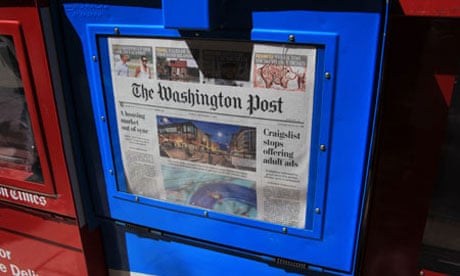To the surprise of many digital evangelizers and old-media doubters, newspaper paywalls turn out to work. Sort of.
The Washington Post and the Daily Telegraph in London are the latest to announce their pay plan, so that, in the foreseeable future, most rather than a select few papers will have implemented some kind of subscription or metered fare.
The New York Times deserves credit for the breakthrough: it created a model that is "porous" enough that if you don't want to pay, you don't have to, and if you read the Times regularly enough and don't care about not paying, you will. This has added a significant new revenue stream, while yet preserving the Times' online advertising income (anemic though that is).
The Times' success turns on its ear the old notion of news economics: that there is enormous price sensitivity among news consumers and that small rises in price mean big circulation drops. (Conversely, as Rupert Murdoch has frequently shown, small drops in cost have meant big circulation rises.) The Times model leads the way to demonstrating, as the news analyst Ken Doctor has observed, a much different conclusion: loyal newspaper readers have minimal price sensitivity, if any at all. This is true for both online and offline subscription costs. Or, put another way, old people will pay anything to maintain their newspaper habit.
Or, put another way still, the paywall, other than providing a bit more time to wrestle with the underlining problems of newspapers, does not solve any of them.
Even with this new class of free-spending readers, the economic problems remain exactly the same:
An extraordinary indifference, if not utter lack of interest, on the part of younger people to news brands and to news habits, a development that established news organizations have been unable to address, stall, or even fathom.
Dramatic abandonment of the medium by traditional advertisers, such that, since 2007, newspapers, according to industry monitor group Outsell, have seen more than a 40% decline in overall income, the overwhelming amount of that drop due to lost ad revenues.
A digital advertising environment on the web – one even more pronounced in mobile – that relentlessly increases the amount of advertising space available and lowers the value of all space overall.
And then there's the competition.
There is an aggressive new news business, including, but hardly limited to, the Huffington Post, the Drudge Report, Business Insider, Buzzfeed, Politico, Yahoo News, and Google News, built on the idea of producing full service news products with significantly fewer resources and at significantly less cost than traditional news organizations – largely, by recycling free digital news feeds.
And now, the next generation of free news may have begun with Yahoo's recent acquisition of Summly, an automatic news summarizer and aggregator. Thus the most pronounced and successful trend in online news is not adding paywalls, but providing more news with significantly fewer people.
Paywalls, in other words, don't alter the existential drama.
Without a dramatic turnaround in advertising income, there are only two strategies – neither mutually exclusive – for the continued existence of newspapers, in digital or any other form:
Having established the paywall model, the goal, in a race against time, is to extend it to a greater and greater part of the user base. Like the paywall itself, this is unchartered territory. Rupert Murdoch's more absolute paywalls having worked significantly less well than the New York Times' porous wall. The Times, however, counting on its brand power and on the gradual change in consumer behavior, is trying to up the ante, recently cutting its free take from 20 to ten articles.
Re-orient the cost basis of the business, still largely modeled on advertising income, to the much smaller subscription revenue base. That is, fire a lot of people.
This is, actually, good news, if not necessarily for shareholders or for many employees. Some newspapers can continue to exist, albeit as vastly smaller and less profitable businesses.
There is, too, the inverse strategy: no paywall. If the Times establishes one model of limited success, the Daily Mail establishes the opposite model of limited success. In essence, the Mail has played an entirely un-newspaper game, much less trying hold onto and finance what has worked offline, and much more trying to focus on what works online. Using large amounts of aggregation, and focusing relentlessly on celebrities, with search engine and social media strategies, it has, in fact, outdone almost all its native online competitors in the quest for traffic and wholly trounced every other newspaper.
Still, given the ever-dropping digital advertising rates, even the Mail, with its traffic gold mine, can't recreate its offline scale.
Curiously, it seems plausible to argue that, given the loyalty of many readers and the digital undermining of advertising income, many newspapers might have fared better having not become digital products. Certainly, all would have fared better if none had.
But the world is as it is.

